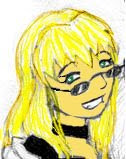 The cure lies in the curse.
The cure lies in the curse.If you like shows like Kino's Journey, Haibane Renmei or
Natsume Yuujin-Chou, then you'll probably enjoy Mushi-Shi (also spelled Mushishi interchangeably, so I'm not sure which is exactly accurate). Much like Kino's Journey, Mushi-Shi follows a lone traveller from place to place as he interacts with various people of different beliefs and backgrounds. It's a very slow paced (in a good way), gently woven, mysterious and supernatural tale of a Mushi Master (a Mushi-Shi) named Ginko who travels the land studying mushi and helping humans deal with mushi problems. Mushi in this series are supernatural creatures connected with the essence of life. So, they're not exactly ghosts, but they behave like spirits and come in many different forms. Most people cannot see Mushi, but Ginko is even rarer in that he actually attracts them. Because of this he has become a traveling Mushi Master, unable to stay in one place for too long. Most mushi are harmless, but even harmless mushi don't always live in harmony with humans, and some others cause great trouble (and even death). So many people will call upon Ginko to aid them with their mushi troubles, which range from mushi that live in a person's eye, causing them to become extremely sensitive to light; to a fungus that uses a human woman's womb to birth its spores.
Most of the episodes are unrelated to each other, episodic, without an underlying connecting story line (much like Kino's Journey, again). However there are a couple of episodes which explore Ginko's past, explaining his odd white hair, his green eyes (and why he is missing one of them), and how he became a Mushi Master. Occasionally a character will reappear, notably another Mushi Master named Adashino and Nui (who physically only appears in one episode, but narrates many of the others), but other than Ginko, there's typically an entirely new cast of characters in each episode.
Ginko is a rather calm, laid back character. He has a clear passion for learning about mushi, and is one of the rare Mushi Masters who prefers to work with the mushi rather than destroy them. He is constantly seen smoking a special type of cigarette (really I think it's only out of his mouth when he's sleeping) which gives off a special smoke that keeps mushi at bay and helps him control them to an extent. He firmly believes that mushi are not evil, and does his best to help humans live in peace with them. Unfortunately, not everyone always agrees with his methods, and sometimes not even Ginko knows the answers to a problem. Often he is forced to search for an unknown cure through the mushi's curse itself.
The 26-episode series is based on the manga series by Yuki Urushibara, which has been published by Del Rey in America. The anime covers about half of the stories in the manga (up to volume 5 or 6). FUNimation produced the English dubbing of the show, and it's excellent. The lovely Travis Willingham (Roy Mustang, Takashi Morinozuka) voices Ginko, and Jennifer Seman is the voice of Nui and the narrator. The animation for the show is really lovely and sets a great tone for the series (though unfortunately the character designs for all but the "main" cast are rather generic). As does the opening theme (though there isn't much to the animation there) "The Sore Feet Song" sung by Ally Kerr. The endings are different instrumental pieces for each episode.

